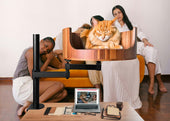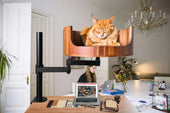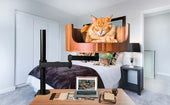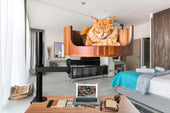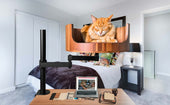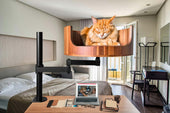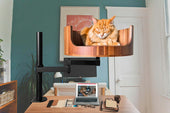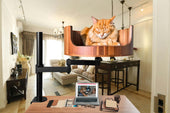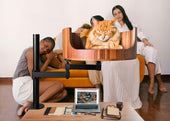
My Cat Vomited Yellow: What You Need to Know
Share
If you have ever woken up to find your beloved feline friend has left a mess of yellow vomit on your carpet, you are not alone. Cats vomiting yellow is a common occurrence that can be alarming to pet owners. In this article, we will delve into the various reasons why your cat may be vomiting yellow, what it could indicate about their health, and what steps you can take to help them feel better.
One possible reason for your cat vomiting yellow is bile. Bile is a fluid produced by the liver and stored in the gallbladder that helps with digestion. When a cat vomits yellow bile, it may indicate that their stomach is empty and the bile is being brought up. Other potential causes of yellow vomit in cats include dietary indiscretions, hairballs, and underlying health issues such as pancreatitis or liver disease. It is important to pay attention to any accompanying symptoms, such as lethargy or loss of appetite, and seek veterinary advice if you are concerned about your cat's health. By understanding why your cat may be vomiting yellow, you can take proactive steps to help them feel better and ensure their well-being.
1. Yellow vomit in cats can be caused by a variety of issues, ranging from simple dietary indiscretions to more serious health concerns.
2. It is important to monitor your cat's behavior and overall health in addition to the color and frequency of their vomit.
3. If your cat consistently vomits yellow or displays other concerning symptoms, it is best to consult with a veterinarian for a proper diagnosis.
4. Possible causes of yellow vomit in cats include liver or gallbladder issues, infections, pancreatitis, and ingesting foreign objects.
5. Treatment for yellow vomit in cats will vary depending on the underlying cause, so prompt veterinary care is essential for your feline's wellbeing.
Causes of Vomiting Yellow in Cats
Yellow vomit in cats can be caused by a variety of factors, including bile, stomach inflammation, liver issues, or something as simple as eating too quickly. Bile is a substance produced by the liver that helps with digestion, and when a cat vomits yellow, it could mean that there is bile present in the vomit. Stomach inflammation, also known as gastritis, can also lead to yellow vomit in cats. Liver issues, such as hepatitis or gallbladder disease, can affect bile production and lead to yellow vomiting. Additionally, if a cat eats too quickly or consumes something that disagrees with their stomach, it can also result in yellow vomit.
When to Seek Veterinary Care
While occasional vomiting may not be cause for concern, frequent or persistent yellow vomit in cats should prompt a visit to the veterinarian. If the vomiting is accompanied by other symptoms such as lethargy, loss of appetite, diarrhea, or abdominal pain, it is important to seek veterinary care promptly. Cats who are vomiting frequently may become dehydrated, which can be dangerous if left untreated. A veterinarian can help determine the underlying cause of the vomiting and provide appropriate treatment to help your cat feel better.
Treatment Options for Cats Vomiting Yellow
Treatment for cats vomiting yellow will vary depending on the underlying cause. In some cases, dietary changes may be recommended to help soothe the stomach and prevent further vomiting. If a cat is diagnosed with gastritis, medications to reduce stomach acid or antibiotics to treat any underlying infections may be prescribed. Cats with liver issues may require special diets or medications to support liver function. In more severe cases, hospitalization and intravenous fluids may be necessary to treat dehydration and provide supportive care.
Prevention Tips to Avoid Yellow Vomit
To help prevent yellow vomit in cats, it is important to feed them a balanced diet and ensure they are not eating too quickly. Providing regular, small meals throughout the day can help prevent stomach upset. Avoid giving your cat table scraps or foods that are known to cause gastrointestinal issues. Additionally, keeping your cat up to date on vaccinations and regular veterinary check-ups can help catch any health issues early and prevent serious complications. If you notice any changes in your cat's vomiting habits or behavior, it is best to consult with your veterinarian for guidance.
Frequently Asked Questions
What could be causing my cat to vomit yellow?
There are several potential causes for your cat vomiting yellow, including hairballs, dietary issues, ingestion of foreign objects, liver problems, or gastrointestinal issues. It is important to monitor your cat's behavior and consult with a veterinarian to determine the root cause.
How can the Desk Cat Nest help with my cat's vomiting issue?
The Desk Cat Nest provides a cozy and comfortable space for your cat to relax and destress, which can help alleviate potential triggers for vomiting such as anxiety or stress. Additionally, the raised design of the desk cat nest can help improve your cat's digestion by encouraging proper posture while eating.
Is the Desk Cat Nest easy to clean in case my cat vomits on it?
Yes, the Desk Cat Nest is designed for easy cleaning. The removable cushion can be machine washed, and the rest of the nest can be wiped down with a damp cloth. This makes it convenient to maintain a clean and hygienic environment for your cat.
Can the Desk Cat Nest be used for cats of all sizes?
The Desk Cat Nest is designed to accommodate cats of various sizes, with a spacious platform that can comfortably fit both small and large cats. The sturdy construction of the nest also ensures that it can support the weight of heavier cats without any issues.
In conclusion, investing in a Desk Cat Bed is a valuable choice for your cat who has vomited yellow. The elevated design of the bed promotes better digestion and reduces the likelihood of stomach upset. Additionally, the comfortable and supportive cushioning of the bed is gentle on your cat's stomach and can help alleviate discomfort. With the Desk Cat Bed, you can provide your furry friend with a cozy and safe resting place that promotes overall health and well-being.










